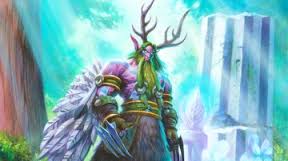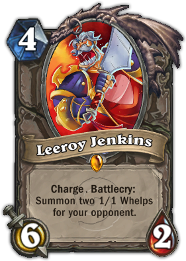Click here for the published version of the article.
by Moonfell and David Wise (WiseTL)
The Curse of Naxxramas adventure mode has and is shaking up the landscape of Hearthstone. We've decided that now is a perfect time for a review of Hearthstone's history much like we did at the end of 2013.
Where we left off last year, Freeze Mage had just been nerfed and Enrage/Combo Warriors were all the rage. In those first few months of Hearthstone, however, the meta shifted almost weekly. As decks became more optimized the game seemed to settle before Naxxramas was released. Part of the reason for this stabilization was the Midrange Druid decks which came out at the beginning of the year. These decks were so stable that they became a gatekeeper of the top tier of decks: no deck without a consistent Druid matchup could consider itself top tier.
There was one deck, however, which comes before the Druids took over. To introduce it, and highlight how unstable the game used to be, here is the last line of the 2013 Review: "Warlock might be the dominant class today, but who knows what innovations or patch changes 2014 will bring. Who knows? Maybe even Hunter will get a chance in the spotlight one day. Nah, probably not."

The Curse of Naxxramas adventure mode has and is shaking up the landscape of Hearthstone. We've decided that now is a perfect time for a review of Hearthstone's history much like we did at the end of 2013.
Where we left off last year, Freeze Mage had just been nerfed and Enrage/Combo Warriors were all the rage. In those first few months of Hearthstone, however, the meta shifted almost weekly. As decks became more optimized the game seemed to settle before Naxxramas was released. Part of the reason for this stabilization was the Midrange Druid decks which came out at the beginning of the year. These decks were so stable that they became a gatekeeper of the top tier of decks: no deck without a consistent Druid matchup could consider itself top tier.
There was one deck, however, which comes before the Druids took over. To introduce it, and highlight how unstable the game used to be, here is the last line of the 2013 Review: "Warlock might be the dominant class today, but who knows what innovations or patch changes 2014 will bring. Who knows? Maybe even Hunter will get a chance in the spotlight one day. Nah, probably not."

Aggro Hunter
Face Hunter made Priest and Paladin decks almost extinct at the time, since the two classes did not have appropriate responses for deck's early-game pressure. While those two classes suffered, Druid, Warrior and other decks were forced to adapt to counter Face Hunter.
The original Hunter Aggro deck and the more familiar one.
Dawn of Midrange Druid

Additionally, Druids benefited from the discovery of the Force of Nature-Savage Roar combo. The combination gave Druids a way to close games with a sudden burst – this 14-damage combo quickly spread to almost all Druid decks.
The Ancient Watcher list and StrifeCro's original build.
Kitkatz Control Warrior
KitKatz Warrior featured many late-game minions such as Alexstrasza, Ysera, Ragnaros, and Grommash Hellscream to win while using Fiery War Axe and Shield Block to stall. The deck also has cheap removal such as Shield Slam and Execute in the early game with Frothing Berserker and Armorsmiths for early board control.
The Kitkatz control Warrior.
Return of the Murlock
Puffins Murlock
Reynad Opens the Zoo
The first Zoo deck is very similar to the present Zoo, but ran Nat Pagle, Tinkmaster, and Blood Imps before the three were nerfed. The first Zoo dominated the meta at the time due to its speed and ferocity. In time, Zoo became the deck to climb the ladder, replacing its Murloc counterpart.
Reynad Zoo
A Legendary Nerf
Tinkmaster Overspark was originally a cost-effective hard removal card. For 3 mana, Tinkmaster
would transform a target creature into a 1/1 squirrel or a 5/5 dinosaur. This was an effective method of removing taunts or neutralizing big creatures like Ragnaros. The balance team at Blizzard believed that Tinkmaster was too effective for its cost. Even though the new Tinkmaster became a 3/3, it could not target which creature to transform, which rendered it too volatile for competitive play.
Second Coming of Hunter Aggro
This deck was also used to counter Zoo. Because Zoo swarmed the board with cheap, weak minions, Hunter efficiently dealt with the deck thanks to Explosive Trap and Unleash the Hounds. Once again, Aggro Hunter dominated the ladder much to the dismay of many players.
Trap-based Hunter Aggro.
The Control Warrior Explosion

Midrange Hunter
Just when Hunter just couldn't get better, it did. Lifecoach made a very unique mid-range deck that combined Steady Shot and UTH with big minions like Savannah Highmane and Houndmaster. Kolento also used this deck frequently and made a name for himself as one of the best Hunter players in the game as he went to Legend rank twice using Hunter.
This particular deck was focused more on board control early while dealing huge damage in the mid game. River Crocolisk, Explosive Trap, and the fear of UTH combo kept opponents in line in the early game while overwhelming them in the mid-game with powerful minions such as Savannah Highmane. Hunter's Mark was also a frequent with deck to give it more removal in conjunction with Stonetusk Boar and UTH. This deck kept a strong presence on ladder and in tournaments until Miracle Rogue emerged as a counter.
Kolento's Midrange Hunter.
A Miraculous Return

Everyone's Favourite
In the beta, Rogue reigned supreme until Blizzard adjusted some combo cards to nerf the class. Rogue seemed mediocre until the current iteration of Miracle Rogue reared its head. The deck relied on cheap spells, Combo cards, and Gadgetzan Auctioneer to draw the necessary pieces to set up a OTK combo (usually with Leeroy, Shadowstep, and Cold Blood). Conceal rendered the Auctioneer practically immune in most cases, which allowed the Rogue to prepare the dreaded OTK in the following turn. The effectiveness of the deck, especially versus Hunter, led to its prolific use. Thanks to the Miracle variation, Rogue still ranks as the top class according to most pros.
Kolento's first Miracle list.
Unleash the Nerfed Hounds
Too Much Burst?

As Hearthstone players spent more time with the various classes, refined methods to abuse high damage combos emerged. As these burst damage combos became more prevalent, HearthTrolden “sexy sax” videos experienced a boon in content. However, to those on the receiving end of these heavy hitting strats, this represented a seemingly unfair and fun-sucking aspect of the game. Miracle Rogue triple Leeroy, Druid Force of Nature/Savage Roar, Shaman Bloodlust/Rockbiter/Windfury, Leeroy/Faceless, Beast/Kill Command, as well as other combos struck fear in all those who dared to drop below 20 health.
A Mage-icle Comeback
Rdu Freeze Mage from Dreamhack.

No comments:
Post a Comment